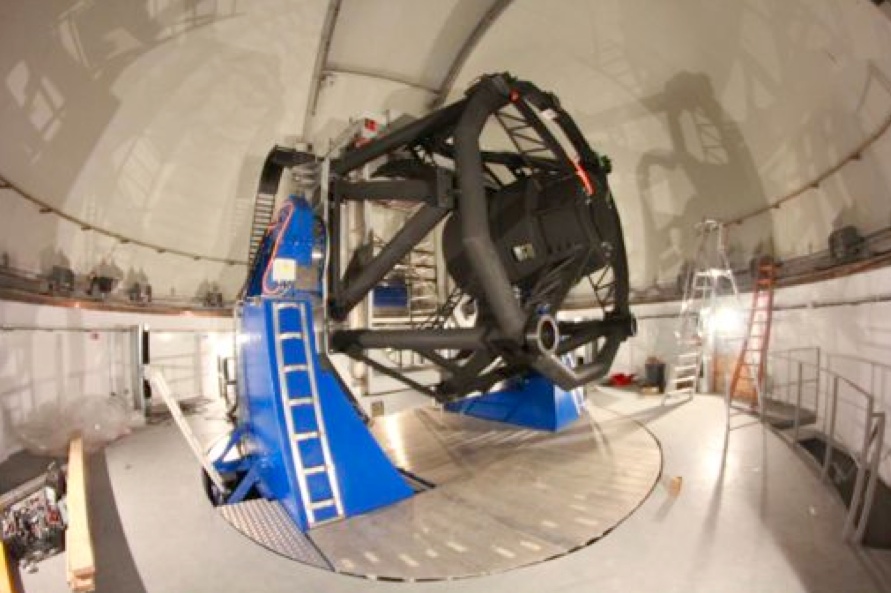AYA2016-81065-C2-2: J-PAS: J-PAS: Estructura a gran escala, cosmologia con oscilaciones acusticas barionicas y cosmologia de proximidad

J-PAS (Javalambre Physics of the Accelerating Universe Astronomical Survey) comenzará a tomar datos con el telescopio de 2.5m del OAJ a fines de 2018, con un plazo previsto de compleción de ocho años. En 2018 se inició el Pathfinder Survey, con una cámara de campo menor. El survey auxiliar J-PLUS comenzó a tomar datos a final de 2015 con el telescopio de 0.8m del mismo OAJ. Cuando se complete JPAS será un mapa de 8500 grados cuadrados observado con 54 filtros estrechos y cinco anchos. La magnitud límite (5sigma) en los filtros estrechos será AB~22.4 hasta 7000 A, bajando a AB~21.2 en el más rojo. Estas características definen un survey con el que se obtendrán redshifts de muy alta calidad para >15M de galaxias rojas luminosas y >70M de galaxias con líneas de emisión. El objetivo principal de J-PAS es estudiar, a través de la medida de BAOs y otros métodos, las propiedades de la energía oscura responsable de la aceleración del Universo. Producirá además un catálogo de ~100M de galaxias con exquisito detalle (comparable con espectroscopía, con precisión de 0.3%), y ~400M de galaxias con precisión comparable a los mejores proyectos fotométricos actuales (ALHAMBRA o COSMOS).
El objeto principal de nuestro subproyecto es aprovechar J-PAS desde el punto de vista astronómico para estudiar las propiedades y la evolución de los objetos que se detecten en él. En particular, analizaremos:
- La estructura a gran escala, su evolución, y como ésta se refleja en la segregación por tipos, o la relación de la segregación con la densidad local.
- Los procesos de formación y evolución de galaxias y su reflejo en la función de luminosidad en diferentes épocas. También la posibilidad de estudiar objetos peculiares (por colores, distancia, o luminosidad) que aparecerán en nuestro proyecto dado su enorme volumen.
- La estructura de agrupamiento de galaxias en escalas muy pequeñas, tanto desde el punto de vista de los halos en que residen como de la interacción a escala de grupos pequeños. En particular, estudiaremos propiedades de galaxias cercanas observadas por J-PAS y JPLUS, y la estructura de satélites de nuestra propia Vía Láctea.
- Finalmente (pero no menos importante), nuestro grupo será responsable dentro del proyecto de las tareas de divulgación de los resultados.
“J-PAS: Large scale structure, cosmology with baryon acoustic oscillations and low-redshift cosmology”. J-PAS (Javalambre Physics of the Accelerating Universe Astronomical Survey) will start taking data with the T250 telescope of the OAJ by the end of 2018, expecting completion in approximately eight years. In 2018 the Pathfinder Survey started, using a smaller field camera. The auxiliary J-PLUS survey started in late 2015, using the T80 telescope of the same Observatory. When completed, JPAS will be a map of 8500 sqdeg observed through 54 narrow- and 5 wide-band filters. The (5sigma) limiting magnitude in the narrow filters will be AB~22.4 up to 7000 A, decreasing to AB~21.2 at the red end. These features define a survey which will yield redshifts of very high quality for >15M luminous red galaxies and >70M emission line galaxies. The primary purpose of J-PAS is to study, through the measurement of BAOs and other methods, the properties of the dark energy which is responsible for the acceleration of the Universe. J-PAS will also produce a catalog of ~100M galaxies with exquisite detail (comparable with spectroscopic data, accurate to 0.3%) , and ~400M galaxies with accuracy similar to the best current photometric projects (like ALHAMBRA or COSMOS).
The main aim of our subproject is to use J-PAS from an "astronomical" point of view to study the properties and evolution of the objects detected in it. In particular, we include:- The large-scale structure, its evolution, and how this is reflected in the type segregation, or the relationship between segregation and local density. - The processes of galaxy formation and evolution, and how they reflect in the luminosity function at different times. The possibility of studying peculiar objects (by color, distance or luminosity) which will appear in our project given the huge volume involved. - Galaxy clustering in the smallest scales, including both the haloes in which they reside or the interaction in the scale of small galaxy groups. We will study data from nearby galaxies observed with J-PAS and J-PLUS and the satellite structure of our own Galaxy. - Last but not least, our group is also responsible for project outreach within J-PAS.
